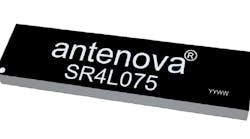Antenova’s Small-Space Antenna Serves 5G and LTE Signals
This article is part of the TechXchange: Device-Level Antenna Selection Considerations.
The Overview
In its Minima model SR4L075 antenna, Antenova now offers the smallest SMD antenna for 5G frequencies it’s ever had. With volume of just 40 x 10 x 3.3 mm and weight of <3 grams, the Minima antenna suits small and lightweight designs for 4G and 5G frequencies, as well as designs that use both frequencies.Who Needs it & Why?
According to Bloomberg, there’s burgeoning demand for high-bandwidth entertainment services, with services such as 4K video streaming and remote AR/VR gaming driving the growth. Meanwhile, oil, gas, mining, and energy utilities are investing in 5G networks to connect millions of industrial IoT (IIoT) devices. Emergency healthcare, transport, smart cities, V2X, and drones will also use 5G.
It’s hoped by Antenova that Minima will help designers future-proof their designs as operators move away from 3G and roll out 5G services. The Global Mobile Suppliers Association (GMSA) reports an increase in super-fast 5G networks and 5G devices, identifying 493 operators in 150 countries that have invested in 5G, and 205 operators in in 80 countries have launched 5G mobile services and 5G devices. The number of devices available for the 5G networks has grown by more than 60% in the last 12 months, according to the GMSA.
Under the Hood
Minima is a multi-band cellular antenna covering the common 4G and 5G frequencies used globally, including the popular Band 71, 617 to 698 MHz, which is used by T-Mobile in the USA. It can therefore be used in designs that will be marketed globally.
The device, which uses minimum space in a design, operates with a small clearance beneath, making it a great candidate for 4G and 5G cellular designs in which space is tight on the PCB. In tests, Antenova claims, Minima achieved efficiencies up to 60%, which will help designers to achieve certification for their 5G designs. The antenna operates on the most common 4G & 5G bands: LTE 700, GSM850, GSM900, DCS1800, PCS1900, WCDMA2100, LTE B7 (2500-2690MHz), LTE B40 (2300 – 2400MHz) and 5G B78 (3300-3800MHz), B71 (617- 698MHz).
For more TechXchange articles on this topic CLICK HERE.
To see TechXchange pages on other topics CLICK HERE.

